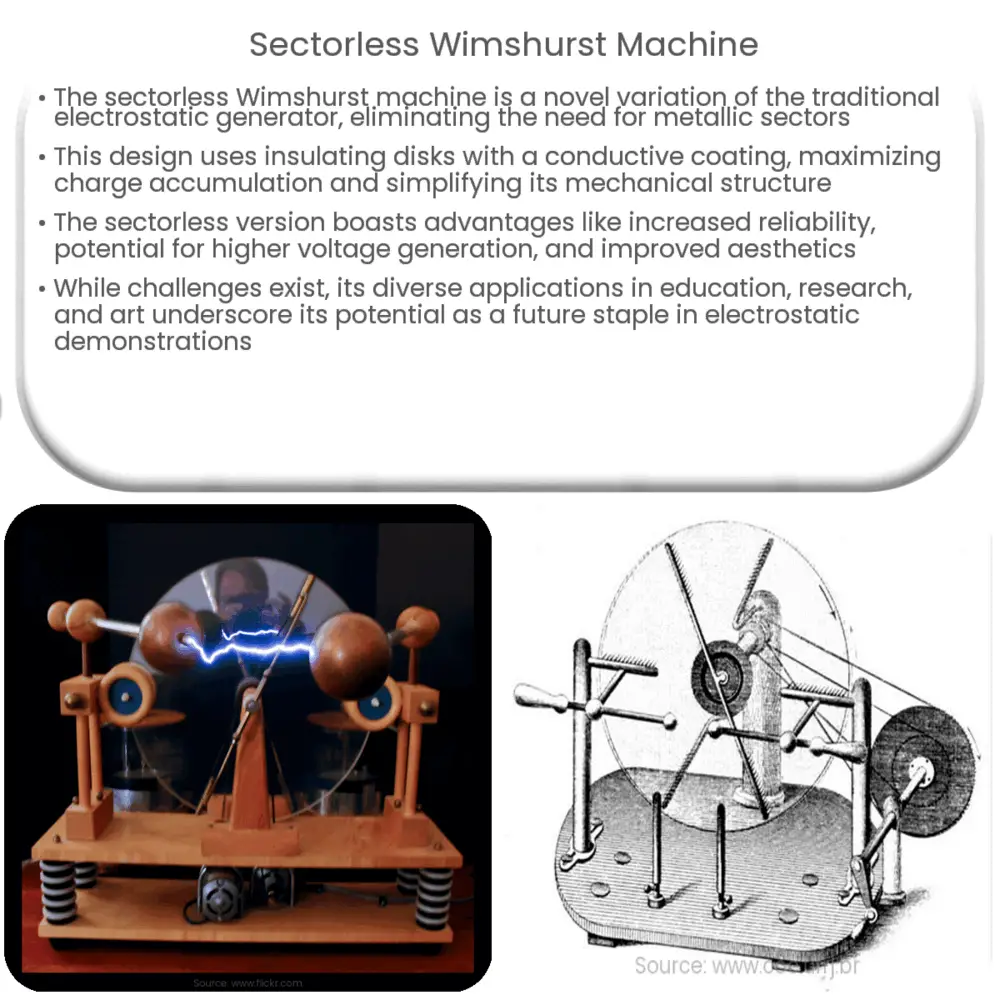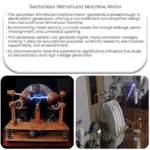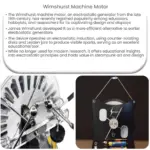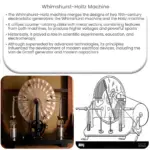The sectorless Wimshurst machine is an electrostatic generator that eliminates metallic sectors, offering improved performance, reliability, and aesthetics.

Sectorless Wimshurst Machine: A New Approach to Electrostatic Generators
Introduction
The Wimshurst machine, an electrostatic generator invented by British inventor James Wimshurst in the late 19th century, has long been a staple in demonstrating electrostatic phenomena in educational settings. It operates by employing counter-rotating disks with metallic sectors attached, which generate electrostatic charges via the process of influence. However, an emerging variation of the Wimshurst machine is gaining attention: the sectorless Wimshurst machine. This new approach removes the metallic sectors and instead relies on the disks themselves to generate and store electrostatic charge, offering several advantages over the traditional design.
How the Sectorless Wimshurst Machine Works
In a sectorless Wimshurst machine, the metallic sectors are replaced by the disks themselves. These disks, typically made of an insulating material like acrylic or glass, are coated with a thin conductive layer, such as aluminum, on one side. The disks are mounted on a central axis and arranged to rotate in opposite directions. A pair of brushes come into contact with the disks’ surfaces, inducing an electrostatic charge through triboelectric effect. The counter-rotating motion of the disks causes the charges to separate and accumulate at the outer edges.
Neutralizing brushes are placed near the outer edges of the disks to collect the charges, which are then transferred to Leyden jars – specialized capacitors used for storing high-voltage charges. The charges in the Leyden jars can be discharged through a spark gap, creating a visible and audible spark that demonstrates the presence of the accumulated electrostatic charge.
Advantages of the Sectorless Design
The sectorless Wimshurst machine offers several advantages over its traditional counterpart:
- Reduced Mechanical Complexity: The removal of metallic sectors simplifies the overall design, which can lead to easier fabrication and assembly, as well as reduced maintenance requirements.
- Improved Reliability: Without the metallic sectors, the risk of charge leakage and arcing between adjacent sectors is eliminated, resulting in a more reliable and consistent performance.
- Greater Charge Accumulation: The sectorless design allows for a larger surface area for charge separation and storage, potentially resulting in higher voltage generation compared to traditional Wimshurst machines.
- Enhanced Aesthetics: The transparent nature of the acrylic or glass disks provides a visually appealing look, making the sectorless Wimshurst machine an attractive option for both educational and decorative purposes.
Despite these advantages, the sectorless Wimshurst machine does present some challenges, such as the need for a conductive coating on the disks and potential issues with brush contact. However, with continued research and development, these issues can be addressed and further improvements can be made to this novel electrostatic generator.
Applications of the Sectorless Wimshurst Machine
Like the traditional Wimshurst machine, the sectorless variant has a range of applications in educational settings, research, and artistic displays:
- Educational Demonstrations: Sectorless Wimshurst machines can be used to teach students about electrostatics, charge separation, and high-voltage phenomena in an engaging and visually appealing manner.
- Scientific Research: As a reliable high-voltage source, the sectorless Wimshurst machine can be utilized in various research fields, including electrostatics, plasma physics, and high-voltage engineering.
- Artistic Displays: The visually striking design of the sectorless Wimshurst machine makes it an ideal choice for science-themed artistic installations and interactive exhibits.
Building Your Own Sectorless Wimshurst Machine
For hobbyists and enthusiasts, constructing a sectorless Wimshurst machine can be an exciting and rewarding project. Here are some steps to guide you through the process:
- Select Materials: Choose an insulating material for the disks, such as acrylic or glass, and a conductive coating, like aluminum or copper. Ensure that the materials are compatible and can be securely bonded together.
- Design and Fabrication: Determine the desired size of the disks, taking into account factors like charge storage capacity and space constraints. Carefully cut the disks and apply the conductive coating on one side, ensuring a smooth and even surface.
- Assembly: Attach the disks to a central axis with a counter-rotating mechanism, and install the brushes for charge induction and collection. Make sure the brushes are properly aligned and maintain good contact with the disks.
- Integration: Connect the neutralizing brushes to Leyden jars for charge storage and add a spark gap to discharge the accumulated voltage. Ensure that all connections are secure and properly insulated.
- Testing and Calibration: Test the assembled sectorless Wimshurst machine by manually rotating the disks or using a motorized drive. Adjust the brushes and spark gap as needed to optimize performance.
Conclusion
The sectorless Wimshurst machine represents an innovative approach to electrostatic generators, offering improved performance, reduced complexity, and enhanced aesthetics compared to the traditional design. While there are challenges to overcome, its potential applications in education, research, and artistic displays make it a promising technology worth exploring. With continued development and refinement, the sectorless Wimshurst machine could become a popular alternative to traditional electrostatic generators in the years to come.




